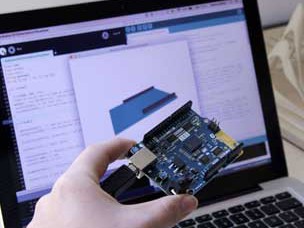
Overview
Max Carrier transforms Portenta modules into single-board computers or reference designs that enable edge AI for high-performance industrial, building automation and robotics applications.
Thanks to dedicated high-density connectors, it can be paired with Portenta X8 or H7, allowing you to easily prototype and deploy your industrial projects.
This Arduino Pro carrier further augments Portenta connectivity options with Fieldbus, LoRa®, Cat-M1 and NB-IoT.
Among the many available plug-and-play connectors there are Ethernet, USB-A, audio jacks, microSD, mini-PCIe, FD-CAN and Serial RS232/422/485.
Max Carrier can be powered via external supply (6-36V) or battery via the onboard 18650 Li-ion battery connector with 3.7V battery charger.
Key benefits include:
- Easily prototype industrial applications and minimize time to market
- A powerful carrier exposing Portenta peripherals (e.g. CAN, RS232/422/485, USB, mPCIe)
- Multiple connectivity options (Ethernet, LoRa®, CAT-M1, NB-IoT)
- MicroSD for data logging operations
- Integrated audio jacks (line-in, line-out, mic-in)
- Standalone when battery powered
- Onboard JTAG debugger via micro-USB (with Portenta H7 only)
Prototyping on Portenta projects
The Arduino Portenta Max Carrier is designed to assist developers with their prototypes by exposing the main peripherals of the high-density connectors of the Portenta family boards (H7 and X8). It allows for easy debugging through the JTAG connector and for inspection of the CAN lines through the pins. At the same time, it is the right tool to test Ethernet connectivity as well as to extend connectivity options (CAT-M1, NB-IoT and LoRa®).
Develop your own Industry 4.0 platform
Combine industrial strength and ease of use with Arduino Pro’s Portenta Max Carrier – designed to give you everything you need to implement edge computing in your smart factory or warehouse with simple plug-and-play features. Optimize your manufacturing process and material flows, control machinery remotely and even prevent failures with preventive maintenance: Max Carrier takes your innovation capabilities to the max.
Arduino Iot Cloud
Integrating with Arduino’s IoT Cloud is a simple and fast way to ensure secure communication for all of your connected Things.
TRY THE ARDUINO IOT CLOUD FOR FREE
Need Help?
Check the Arduino Forum for questions about the Arduino Language, or how to make your own Projects with Arduino. If you need any help with your board, please get in touch with the official Arduino User Support as explained in our Contact Us page.
Warranty
You can find your product warranty information here.
*Portenta X8 is not included in the product: Pictures shown are for illustration purposes only.
Tech specs
| Connectors |
|
| Audio |
|
|
Memory |
|
| Wireless modules |
|
| Operating temperatures |
|
| Dimensions |
|
| Debugging |
|
| Power/Battery |
|
Resources for Safety and Products
Manufacturer Information
The production information includes the address and related details of the product manufacturer.
Arduino S.r.l.
Via Andrea Appiani, 25
Monza, MB, IT, 20900
https://www.arduino.cc/
Responsible Person in the EU
An EU-based economic operator who ensures the product's compliance with the required regulations.
Arduino S.r.l.
Via Andrea Appiani, 25
Monza, MB, IT, 20900
Phone: +39 0113157477
Email: support@arduino.cc
Documentation
Learn more
Get Inspired

A few weeks ago, an announcement was posted on the Arduino Forum mentioning new improvements on the software side of the Arduino/Genuino 101. With this release, the board--which was developed in collaboration with Intel--is reaching its full potential, with not only better code generation but unlocking useful features to make your sketches even more interactive as well. You can easily upgrade the core using the Arduino IDE’s Board Manager (pictured below), while Arduino Create users will be automatically updated, so no action is required--the cool thing about the cloud! In more detail: The GCC compiler has been updated to support hardware extensions to the ARC EM core in the Intel® Curie™ module. This provides significant improvements in floating point operations, bit shifting, and other operations to enhance Sketch performance. The Arduino/Genuino 101 platform offers 2MB Flash storage onboard, which is now enabled for user sketches. An experimental driver has been implemented to enable the I2S interface via the CurieI2S library. Connecting the I2S bus to an external DAC (digital to analog converter) allows users to play high-quality music (HiFi). Other improvements and bug fixes: Motion Sensor: Several sample sketches, like MotionDetection, have been implemented to demonstrate the application of the IMU data Bluetooth LE: Several new examples for BLE peripheral library added IMU: Correct motion detection setting implemented Library CurieTimerOne APIs are now compatible with the TimerOne library For comprehensive release notes refer to the Intel Open Source Technology Center on GitHub.









